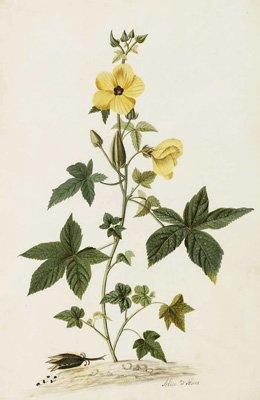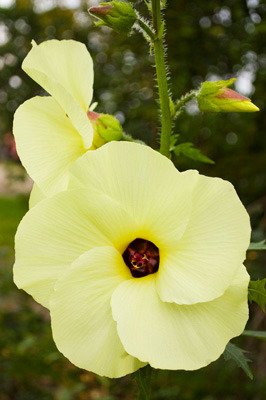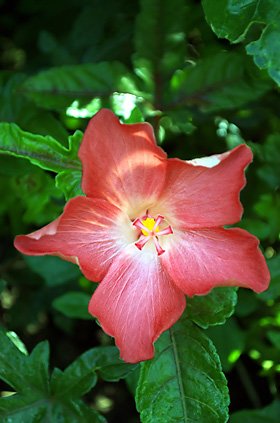





Abelmoschus may sound like a virus you don’t want to catch from your snuffly child, but it actually means “father of musk” in Arabic and designates plants closely related to hibiscus. The best known variety is okra (Abelmoschus esculentus), also called gumbo for the dish in which it frequently appears. Like gorgeous gumbo, several other types of abelmoschus are striking and edible enough to earn a place in both flower and vegetable gardens.
 Even though I’ve grown the sunset hibiscus (Abelmoschus manihot)--often called ‘Lemon Slice’--at least twice, it never occurred to me that I should try to eat it. I didn’t know at the time that its high-protein leaves have made it the “sweet hibiscus," also known as aibika and a popular vegetable in some parts of the world.
Even though I’ve grown the sunset hibiscus (Abelmoschus manihot)--often called ‘Lemon Slice’--at least twice, it never occurred to me that I should try to eat it. I didn’t know at the time that its high-protein leaves have made it the “sweet hibiscus," also known as aibika and a popular vegetable in some parts of the world.
According to the Australian Centre for International Agricultural Research, the plant has the most nutritional value of any leafy vegetable which the centre analyzed. Manihot derives from the resemblance of its palmate leaves to those of cassava (tapioca).
The sunset hibiscus shoots up rapidly and can reach a 6 or 7-foot height in its first year. When grown as an annual, it flaunts 6-inch pale yellow flowers with purple or dark maroon eyes in late summer or early autumn. It can be perennial in USDA zones 8 through 12, but generally dies back to its roots there over winter.
 The musk mallow (Abelmoschus moschatus), pictured in the antique image to your upper left, looks somewhat similar to manihot, but with 3 to 4-inch flowers and a more droopy growth habit. Its essential oil once served as a substitute for more expensive musks. These days, however, the flower also comes in red or pink as ‘Mischief’ or “Pacific’ series cultivars.
The musk mallow (Abelmoschus moschatus), pictured in the antique image to your upper left, looks somewhat similar to manihot, but with 3 to 4-inch flowers and a more droopy growth habit. Its essential oil once served as a substitute for more expensive musks. These days, however, the flower also comes in red or pink as ‘Mischief’ or “Pacific’ series cultivars.
My potted musk mallow plant is supposed to be the red type of 'Mischief,’ though it also looks similar to photos I’ve seen of Abelmoschus moschatus subsp. tuberosus. And, yes, ‘Mischief’ tends to die back during winter too—even under my plant lights.
 A weed in some parts of the world, the wild musk mallow or native rosella pictured in the thumbnail can grow into a 5-foot shrub with maroon-centered white flowers. Its species name, Abelmoschus ficulneus (“of the fig tree”), compares its three-lobed leaves to the fig’s.
A weed in some parts of the world, the wild musk mallow or native rosella pictured in the thumbnail can grow into a 5-foot shrub with maroon-centered white flowers. Its species name, Abelmoschus ficulneus (“of the fig tree”), compares its three-lobed leaves to the fig’s.
Because abelmoschus seeds are hard-shelled, I generally chip and soak them before sowing them. You can do this too, by holding each seed atop a cutting board with needle-nosed pliers while you nick a tiny piece out of its rounded side with the tip of a utility knife. Then submerge the seeds in water overnight before planting them about 1/16 inch deep the next day.
Seeds treated in this way generally will germinate within three to five days under warm conditions. Without the pretreatment, they may take two to four weeks to pop up.
However, when I tried my usual technique this year with a rare type of moschatus, the seedlings which emerged were splotched with white variegation and eventually damped off. So I can’t guarantee that “chip and soak” will always work!
I would recommend that you read up on these plants first, if you decide you want to eat them, as--except for okra's seedpods--I still haven't tried consuming an abelmoschus myself. I would consider that a dreadful waste of a truly flamboyant flower!
Photos: The Abelmoschus manihot and moschatus 'Mischief' photos are my own. The Abelmoschus ficulneus thumbnail is by Gail Hampshire, courtesy of Flickr Creative Commons and this license. The antique Abelmoschus moschatus image is by J. Moninckx, from Moninckx Atlas, Volume 4, courtesy of plantillustrations.org.
Copyright © www.100flowers.win Botanic Garden All Rights Reserved